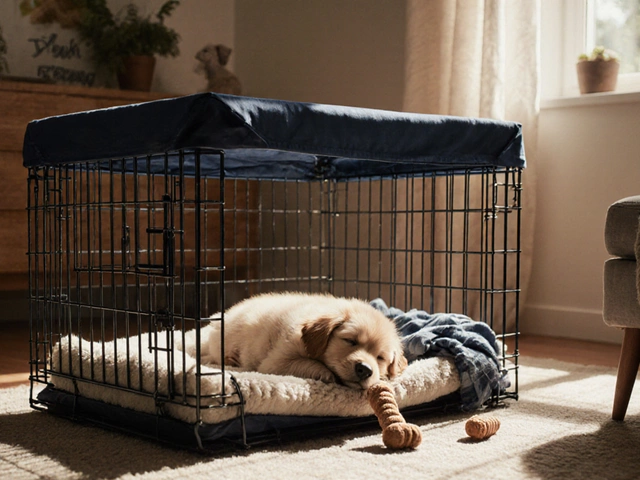
Dog Cargo Safety Risk Calculator
Assess Your Dog's Cargo Safety Risk
This tool helps determine if your dog is safe to fly in the cargo hold based on key risk factors from the article. For high-risk situations, we recommend considering alternatives.
Thousands of dogs fly in cargo holds every year. Some arrive healthy. Others don’t. If you’re thinking about sending your dog in the cargo hold, you’re not just asking if it’s allowed-you’re asking if it’s safe. The truth isn’t simple. It depends on the airline, the breed, the weather, and how well you prepare.
What Happens in the Cargo Hold?
The cargo hold isn’t a basement with crates stacked like boxes. It’s a pressurized, temperature-controlled space designed to carry luggage, freight, and live animals. But that doesn’t mean it’s comfortable. The area is dark, noisy, and isolated. Your dog won’t see you. They won’t hear your voice. They’ll be alone with the rumble of engines and the occasional jolt from turbulence.
Airlines classify cargo holds as Class I or Class II. Class I is climate-controlled and pressurized-same as the passenger cabin. Class II isn’t. Most major U.S. airlines like Delta, United, and American use Class I for live animals. But smaller regional carriers or international flights on budget airlines sometimes use older, less reliable systems. Always ask the airline directly. Don’t trust what you read online.
Which Dogs Are at Highest Risk?
Not all dogs handle cargo travel the same. Flat-faced breeds-like Bulldogs, Pugs, Shih Tzus, and Boston Terriers-are at serious risk. Their shortened airways make it harder to breathe under stress, especially in warm or fluctuating temperatures. In 2023, the U.S. Department of Transportation reported that brachycephalic breeds made up 68% of all animal fatalities during air transport, even though they represent only about 15% of pets flown.
Small dogs under 20 pounds often get shipped in the cabin. But if they’re too big or the airline doesn’t allow it, they’re forced into cargo. Older dogs, dogs with heart conditions, or those on medication are also more vulnerable. A 12-year-old Labrador with arthritis might handle a short flight fine. But if the plane is delayed on the tarmac in 90-degree heat, that same dog could suffer heatstroke before takeoff.
Temperature Extremes Are the Biggest Killer
The most common cause of pet deaths in cargo isn’t turbulence or poor ventilation-it’s temperature. Airlines have policies against loading animals when ground temperatures exceed 85°F (29°C) or drop below 45°F (7°C). But these rules aren’t always enforced. In 2022, a dog died at Atlanta’s airport after being left on a hot tarmac for over four hours before loading. The airline claimed the temperature was “within limits,” but the temperature sensor was broken.
Even if the hold is climate-controlled, delays happen. Planes sit on the runway. Baggage handlers don’t rush. If your dog is loaded last, they might wait in an unairconditioned trailer for 90 minutes. No one checks on them. No one knows they’re there. That’s why many experts recommend flying in the early morning or late evening-when ground temps are safest.

How to Reduce the Risk
If you must fly your dog in cargo, here’s what actually works:
- Choose the right airline. Look for airlines with a published Animal Transport Policy and a dedicated pet team. Delta Cargo, United PetSafe, and Alaska Airlines have the best track records. Avoid airlines with more than 10 pet deaths reported in the last three years.
- Book a direct flight. Every layover means another transfer, another delay, another chance for something to go wrong. Even a 2-hour stop increases the risk by 40%, according to a 2024 study by the American Veterinary Medical Association.
- Use an IATA-approved crate. It must be large enough for your dog to stand, turn, and lie down. No wheels, no soft sides, no absorbent bedding. Use a plastic crate with metal doors. Line the bottom with a towel-nothing fluffy.
- Label everything. Write your name, phone number, and vet’s number on the crate in permanent marker. Tape a copy of your dog’s health certificate inside the crate. Attach a water bottle with a spout that doesn’t leak.
- Don’t sedate your dog. Sedatives can lower blood pressure and make breathing harder. The FAA and AVMA both warn against it. Instead, tire your dog out with a long walk the night before. Skip food 4-6 hours before the flight to prevent motion sickness.
What the Law Actually Says
The U.S. Department of Agriculture (USDA) regulates animal transport under the Animal Welfare Act. But enforcement is weak. Airlines report incidents voluntarily. Only 37% of pet deaths in cargo are officially documented. Many go unreported because owners don’t know how to file a complaint-or they’re too upset to try.
In 2025, the FAA proposed new rules requiring airlines to install temperature monitors inside animal crates. But the rule isn’t final yet. Until then, you’re responsible for your dog’s safety. Don’t assume the airline has your back.
Alternatives to Flying in Cargo
If your dog is a brachycephalic breed, elderly, or anxious, consider alternatives:
- Ground transport. Professional pet transport services like PetRelocation or CitizenShipper offer door-to-door delivery with trained handlers. Costs range from $800 to $2,500 depending on distance.
- Drive with your dog. If the trip is under 1,000 miles, driving gives you full control. Stop every 2-3 hours. Bring water, a portable bowl, and a familiar blanket.
- Wait for a cabin flight. Some airlines allow small dogs in the cabin if they fit under the seat. If your dog is close to the size limit, try a soft-sided carrier. It’s lighter and more flexible than hard crates.

Real Stories, Real Consequences
In 2023, a family flew their 3-year-old French Bulldog from Florida to Colorado. The flight was delayed. The plane sat on the tarmac for 3 hours in 92°F heat. When they arrived, the dog was unresponsive. They rushed him to a vet. He survived-but with permanent lung damage. The airline offered a $500 voucher. No apology.
Another owner shipped her 14-year-old Chihuahua from New York to California. The crate arrived damaged. The dog was found curled up, cold, and dehydrated. The airline said the crate was “not properly secured.” The dog passed away two days later.
These aren’t rare cases. They’re preventable.
When to Say No
Ask yourself: Is this trip necessary? Can it wait? Can my dog handle it?
If your dog has any of these conditions, don’t fly them in cargo:
- Brachycephalic breed (flat face)
- Over 10 years old
- Heart or respiratory disease
- Recently had surgery
- On anxiety or pain medication
- Has had a bad reaction to travel before
If you answer yes to any of these, find another way. Your dog’s life isn’t worth the convenience of a flight.
Final Thought: It’s Not About Rules. It’s About Care.
Airlines have rules. But rules don’t keep dogs alive. People do. If you’re willing to go the extra mile-calling the airline, checking the weather, picking the right crate, skipping the sedative-you’re already doing better than most. But if you’re cutting corners because it’s easier, you’re putting your dog at risk.
Flying with your dog in cargo isn’t a decision you make lightly. It’s a decision you make after you’ve exhausted every other option. And if you’re still unsure? Wait. Drive. Hire a driver. Do anything but send them into the dark, noisy hold without a plan.
Is it illegal to fly a dog in cargo?
No, it’s not illegal. Most airlines allow it under federal guidelines. But many states and countries have stricter rules. For example, California bans flying brachycephalic breeds during summer months. Always check local laws before booking.
How much does it cost to fly a dog in cargo?
Costs range from $200 to $1,200, depending on size, distance, and airline. Delta Cargo charges $300 for a 30-pound dog within the U.S. United PetSafe charges $400 for the same route. International flights can cost over $1,000. Always get a written quote before booking.
Can I visit my dog before the flight?
Some airports let you say goodbye at the cargo facility. Others don’t allow access. Call the airline’s pet desk ahead of time. If you can’t see your dog, ask for a photo confirmation after loading. Reputable airlines will provide one.
What should I put in my dog’s crate?
Only a soft towel or blanket. No toys, no food bowls, no chew bones. These can become choking hazards during turbulence. Attach a water bottle with a spout. Do not use absorbent pads-they can trap heat and moisture. The crate should be empty except for your dog and one familiar item, like a worn T-shirt with your scent.
What if my dog doesn’t make it?
File a report with the airline immediately. Get a copy of the animal incident report. Contact the USDA’s Animal and Plant Health Inspection Service (APHIS) to file a formal complaint. You may be eligible for compensation, but don’t expect justice. Most airlines limit liability to $5,000 per pet, even if your dog is worth more.








Write a comment